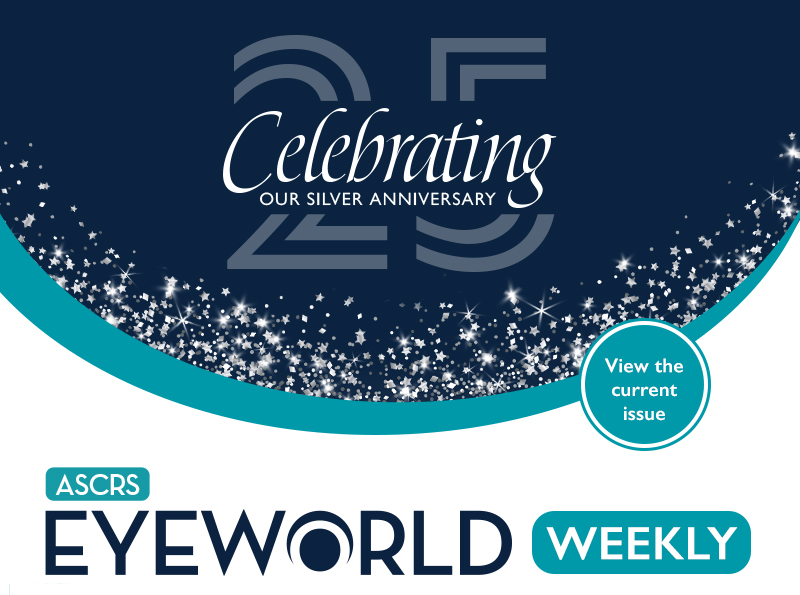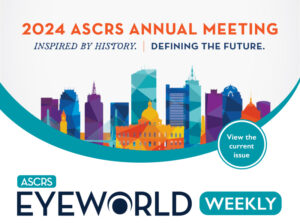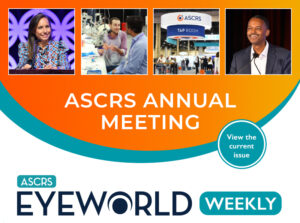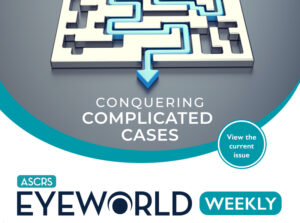
- Patient enrollment complete for Phase 2 trial of DED drug candidate
- New investigational drug candidates for cornea, glaucoma, and wet AMD
- IND filed for glaucoma drug candidate
- Collaboration for one-time treatment of several retinal conditions
- ASCRS news and events
September 17, 2021 • Volume 27, Number 37
Patient enrollment complete for Phase 2 trial of DED drug candidate
Stuart Therapeutics completed patient enrollment for its Phase 2 clinical trial evaluating ST-100, a topical drug candidate for dry eye disease. According to the company’s press release, ST-100 is based on a platform called PolyCol, which is a synthesized polypeptide that repairs tissues, specifically collagen and collagen-containing structures. The Phase 2 trial enrolled 150 patients and is multicenter, randomized, double masked, and placebo controlled to assess the safety and efficacy of the drug candidate. According to the company, the PolyCol platform facilitated healing and reduced inflammation in ocular tissues during in vitro and in vivo preclinical studies.
New investigational drug candidates for cornea, glaucoma, and wet AMD
Visus Therapeutics announced new drug candidates under investigation for corneal wound healing/ocular surface disease, glaucoma, and wet AMD. In addition to BRIMOCHOL, the company’s presbyopia-correcting drop currently in Phase 2 trials, Visus described VT-201, VT-301, VT-401, and VT-501. The latter three drugs are being developed through an exclusive licensing agreement with Cella Therapeutics. The company also announced a novel drug delivery platform that it licensed from DelSiTech, which is silica based and sustained release. VT-201 is a preclinical candidate that belongs to a class of peptides called histatins, which have wound healing, anti-inflammatory, and anti-microbial properties. VT-301 is a sustained-release formulation of bimatoprost acid delivered via injection to the vitreous body for IOP management, according to the company. VT-401 combines bimatoprost acid and a CNTF analog compound that Visus stated could manage IOP, prevent vision loss, and potentially improve vision. VT-501, according to Visus’ press release, combines cell death signal inhibitors and neurotrophic factors to promote cell survival, reducing retinal cell loss for patients with AMD.
IND filed for glaucoma drug candidate
TearClear filed an investigational new drug (IND) application for TC-002 (latanoprost ophthalmic solution, 0.005%). TearClear is developing formulations of drugs like TC-002 that have BAK preservatives while in the bottle but that are preservative-free upon delivery to the eye.
Collaboration for one-time treatment of several retinal conditions
AbbVie and REGENXBIO announced their partnership to develop and commercialize RGX-314, a one-time gene therapy for wet AMD, diabetic retinopathy, and chronic retinal diseases. According to the companies’ press release, a pivotal trial is underway for RGX-314 as a treatment for wet AMD with subretinal delivery, and two Phase 2 trials are being conducted for in-office suprachoroidal delivery for wet AMD and diabetic retinopathy. REGENXBIO will complete the current ongoing trials with RGX-314 under the terms and, from there, AbbVie and REGENXBIO will collaborate and share costs of additional trials. AbbVie, according to the press release, would lead development and commercialization of the therapy globally and REGENEXBIO would participate in U.S. commercialization.
ASCRS news and events
- ASCRS Journal Club: Plan to join ASCRS’ interactive Journal Club on Thursday, September 23 from 9:00–10:00 p.m. ET for another session in this monthly series where a panel of experts discuss two pre-selected manuscripts from the Journal of Cataract & Refractive Surgery (JCRS). Learn more.
- 2022 ASCRS Annual Meeting: ASCRS is accepting submissions for courses, papers, posters, films, and photos until October 11. Visit the Call for Submissions website for more information about the submission process.
- ASCRS Glaucoma Building Blocks: Registration is open for a limited time for this complete, on-demand CME series in comprehensive glaucoma management. Learn more and register for this program to strengthen your foundation in modern glaucoma management.
- CME opportunity: “ASCRS Satellite CME: Supplemental Education to the ASCRS Annual Meeting” includes four, 1-hour programs captured from the 2021 Annual Meeting that are now available online and on-demand for viewing/claiming credit. Learn more.
Research highlights
- Analysis of more than 12,000 adults between 55–73 years old in the U.K. Biobank revealed associations with some ocular and systemic conditions with dementia risk. Participants were assessed between 2006–2010 as a baseline and followed up through early 2021. The research published in the British Journal of Ophthalmology found that diabetes, heart disease, stroke, and depression at baseline were associated with an increased risk of developing dementia. Individuals with a systemic condition and an ocular condition like AMD, cataract, or eye disease related to diabetes were also at higher risk for dementia. AMD and diabetes, according to the research, was associated with the highest risk for incident dementia. Glaucoma was not associated with an increased risk of dementia.
- Use of a dichoptic digital therapeutic for amblyopia was evaluated in a Phase 3 randomized, controlled trial published in the journal Ophthalmology. The study included 105 patients ages 4–7 years with amblyopia who received the digital treatment (n=51) or served as the comparison (n=54). At 12 weeks, those with the digital treatment improved 1.8 lines of VA in the amblyopic eye, while the comparison group improved 0.8 lines. The study authors reported that the difference between the groups was significant and was stopped early as a result of the success. There were no serious adverse events. The authors recommend that future studies evaluate the digital treatment compared to other treatment modalities and in other patient populations.
This issue of EyeWorld Weekly was edited by Stacy Jablonski and Liz Hillman.
EyeWorld Weekly (ISSN 1089-0319), a digital publication of the American Society of Cataract and Refractive Surgery (ASCRS), is published every Friday, distributed by email, and posted live on Friday.
Medical Editors: Eric Donnenfeld, MD, Chief Medical Editor; Rosa Braga-Mele, MD, Cataract Editor; Clara Chan, MD, Cornea Editor; Nathan Radcliffe, MD, Glaucoma Editor; and Vance Thompson, MD, Refractive Editor
For sponsorship opportunities or membership information, contact: ASCRS • 12587 Fair Lakes Circle • Suite 348 • Fairfax, VA 22033 • Phone: 703-591-2220 • Fax: 703-591-0614 • Email: ascrs@ascrs.org
Mention of products or services in EyeWorld Weekly does not constitute an endorsement by ASCRS.
Click here to view our Legal Notice.
Copyright 2021, EyeWorld News Service, a division of ASCRSMedia. All rights reserved.



